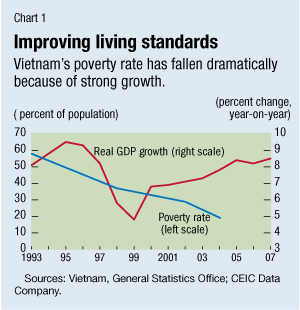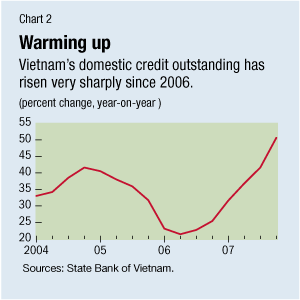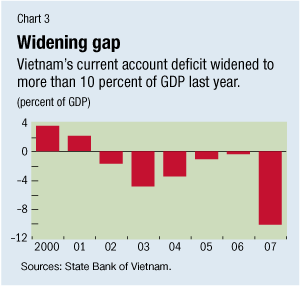
Typical street scene in Santa Ana, El Salvador. (Photo: iStock)
IMF Survey: Vietnam's New Challenges Amid Signs of Overheating
March 7, 2008
- Greater global integration should spur further Vietnamese growth
- But Vietnam faces combination of a slowing global economy and need to rein in domestic and external imbalances
- Government attaches priority to ensuring macroeconomic stability and advancing structural reforms
Vietnam has emerged in recent years as one of the world's most attractive new investment destinations.

Check-out line in Hanoi where retail trade has been booming, stimulated by Vietnam's strong economic growth. (photo: Hoang Dinh Nam/AFP)
Concerns about credit growth
The country's 2007 accession to the World Trade Organization (WTO) and a surge of new foreign direct investment and portfolio inflows, highlight an impressive course of economic reform, particularly in trade and investment liberalization.
These reforms have led to strong economic performance—an average 7.5 percent annual growth over the past decade, one of the fastest rates in Asia (see chart 1).

The number living below the poverty line has fallen from 58 percent of the population in 1993 to less than 20 percent in 2004. Growing access to international markets and greater opening of the domestic economy will likely bring further benefits in the years ahead.
However, increased integration in the global economy has posed significant challenges to Vietnam. The government needs to maintain sound macroeconomic policy, increase policy flexibility to deal with new risks, and press ahead with its broader reform agenda.
Increasing vulnerability
While Vietnam's recent economic performance has rightly drawn much praise, there are increasing signs that the economy is overheating, threatening sustained economic growth over the medium term.
Increasing domestic and external imbalances are a major concern. Credit growth has risen to about 50 percent (see Chart 2), contributing to a rise in inflation, which exceeded 14 percent in January 2008.

Property prices in large cities are also rising sharply. While exports continued to grow strongly, strong demand pressures have fueled rapid import growth, resulting in a sharp widening of the trade deficit. Preliminary estimates suggest that the external current account deficit may have reached about 10 percent of GDP in 2007 (see Chart 3) and that its financing shifted toward capital flows other than foreign direct investment and concessional aid flows.

A slowdown in the United States and Europe, which are Vietnam's largest export markets, will confront Vietnam with two challenges: first, it will likely require some downward revision in the government's growth target for 2008—growth is currently targeted to rise to 9 percent from 8.5 percent in 2007; second, it would further widen the external current account deficit, and thus increase Vietnam's vulnerability to external shocks, a vulnerability heightened by the relatively rigid exchange rate regime.
Key challenges
An immediate policy challenge for Vietnam is to reduce domestic and external imbalances by:
• Reining in rapid credit growth. The recent increase in interest rates and the decision to raise the reserve requirement in June 2007 and February 2008 are welcomed steps in the right direction. However, the State Bank needs to make more effective use of interest rate policy to ensure that market interest rates are positive in real terms, without disrupting financial intermediation in the banking system. Taking steps to address imprudent lending practices in commercial banks will also be a priority.
• Adopting greater exchange rate flexibility. Vietnam has a de facto currency peg to the dollar, which has complicated monetary policy in the face of large capital inflows. A more flexible exchange rate regime would make monetary policy more effective, thereby assisting macroeconomic management. It also would create an incentive to manage exchange rate risks effectively, deepen financial markets, and enhance Vietnam's resilience to external shocks.
• Restraining public sector expenditures. Monetary policy will need to be complimented by restraining off-budget and state-owned enterprises (SOE) expenditures, which resulted in a sharp increase in public sector borrowing in 2007. Since there is a great need to improve Vietnam's infrastructure, the emphasis should be on improving the efficiency of public sector investment and scaling back unproductive projects. In this context, the expeditious implementation of SOE reforms, including the equitization program, can play an important role. Equitization is a form of privatization, involving the sale of shares representing a portion of state capital in an enterprise.
Need for banking reform
Over the medium term, Vietnam needs to advance structural reform to sustain high growth. One of the key priorities is banking sector reform, which will help develop the banking sector and safeguard its stability. The planned equitization of state-owned commercial banks, and the development of a sound regulatory and supervisory framework are an important step in this process. Advancing tax reform, improving the business environment, and enhancing human capital are also high on the reform agenda.
The government has recognized these challenges and significantly tightened monetary conditions in early 2008. More recently, the government announced that it will implement monetary and fiscal policies effectively to ensure macroeconomic stability. With the government's strong commitment to sound economic management and reform, Vietnam has good prospects for sustained growth and poverty reduction in the medium term.
Comments on this article should be sent to imfsurvey@imf.org







